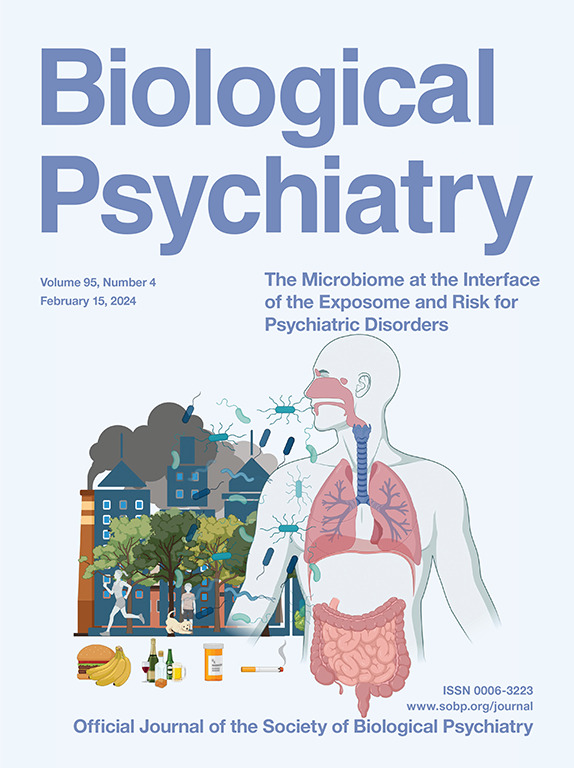代谢负荷与抑郁、焦虑和自杀的关系:一项前瞻性队列研究。
IF 9
1区 医学
Q1 NEUROSCIENCES
引用次数: 0
摘要
背景:静态负荷(AL)是临床实践中对慢性压力的生物成分的客观测量,可能会影响抑郁、焦虑和自杀。本研究调查了AL与这些精神障碍之间的关系:在这项对 333,017 名成人进行的队列研究中,观察了 2006 年 3 月 13 日至 2022 年 10 月 31 日期间未被诊断出抑郁、焦虑或自杀的参与者。使用反映代谢、心血管和炎症失调的 10 种生物标志物对 AL 进行估计。诊断基于国际疾病分类第十次修订版(ICD-10)。我们采用 Cox 比例危险模型来评估 AL 与这些精神疾病之间的关系。此外,我们还对性别、年龄和汤森贫困指数(TDI)进行了亚组分析,并进行了敏感性分析:中位随访期为 12.99 年。在随访期间,13441 人(4.04%)患上抑郁症,13903 人(4.17%)患上焦虑症,796 人(0.24%)自杀。在完全调整模型中,AL值高的人患抑郁症(HR = 1.389,P = 8.38 ×10-27)、焦虑症(HR = 1.304,P = 5.82 ×10-19)和自杀(HR = 1.433,P = 4.46 ×10-3)的风险增加。高AL值的女性和年轻人易患抑郁症和焦虑症,而中等AL值水平的男性和年轻人则与自杀密切相关。此外,中度和高度AL患者合并抑郁和焦虑的风险也较高:高AL与抑郁、焦虑和自杀风险的增加呈正相关,突出了其作为心理健康预测工具的潜力。本文章由计算机程序翻译,如有差异,请以英文原文为准。
Association of Allostatic Load With Depression, Anxiety, and Suicide: A Prospective Cohort Study
Background
Allostatic load (AL) is an objective measure of the biological components of chronic stress in clinical practice, which potentially influence depression, anxiety, and suicide. In this study, we investigated the association between AL and these mental disorders.
Methods
In this cohort study of 333,017 adults, participants without previous diagnoses of depression, anxiety, or suicide were observed from March 13, 2006, to October 31, 2022. AL was estimated using 10 biomarkers that reflect metabolic, cardiovascular, and inflammatory dysregulation. Diagnoses were based on ICD-10. We performed Cox proportional hazard models to assess the relationship between AL and these mental disorders. We also conducted subgroup analyses for sex, age, and Townsend Deprivation Index, as well as sensitivity analyses.
Results
The median follow-up period was 13 years. Over the follow-up period, 13,441 (4.04%) participants developed depression, 13,903 (4.17%) developed anxiety, and 796 (0.24%) committed suicide. In the fully adjusted model, individuals with high AL had an increased risk of depression (hazard ratio = 1.389, p = 8.38 × 10−27), anxiety (hazard ratio = 1.304, p = 5.82 ×10−19), and suicide (hazard ratio = 1.433, p = 4.46 ×10−3). Women and younger individuals with high AL were vulnerable to depression and anxiety, while moderate AL levels were significantly associated with suicide in men and younger participants. Moreover, individuals with middle and high AL had an elevated risk of comorbid depression and anxiety.
Conclusions
High AL is positively associated with increased risks of depression, anxiety, and suicide, highlighting its potential as a predictive tool in mental health.
求助全文
通过发布文献求助,成功后即可免费获取论文全文。
去求助
来源期刊

Biological Psychiatry
医学-精神病学
CiteScore
18.80
自引率
2.80%
发文量
1398
审稿时长
33 days
期刊介绍:
Biological Psychiatry is an official journal of the Society of Biological Psychiatry and was established in 1969. It is the first journal in the Biological Psychiatry family, which also includes Biological Psychiatry: Cognitive Neuroscience and Neuroimaging and Biological Psychiatry: Global Open Science. The Society's main goal is to promote excellence in scientific research and education in the fields related to the nature, causes, mechanisms, and treatments of disorders pertaining to thought, emotion, and behavior. To fulfill this mission, Biological Psychiatry publishes peer-reviewed, rapid-publication articles that present new findings from original basic, translational, and clinical mechanistic research, ultimately advancing our understanding of psychiatric disorders and their treatment. The journal also encourages the submission of reviews and commentaries on current research and topics of interest.
 求助内容:
求助内容: 应助结果提醒方式:
应助结果提醒方式:


